Fleas are bloodsucking insects that attack all kinds of domestic and wild mammals and birds. They are the most common and important external parasites of dogs and cats worldwide. It is very likely that dogs or cats get fleas sometime during their life, wherever they live. And as everybody knows, if a pet gets fleas, its owner will most likely get them as well. For solving flea problems or to prevent them it is very useful to know how fleas live and reproduce.
In this site there is also a specific article on fleas on livestock and their control.
Flea species on dogs and cats
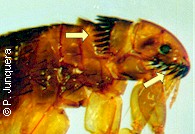
Fleas of cats and dogs belong to the insect order called Siphonaptera. Worldwide there are more than 2000 species that attack pets, livestock, humans and also wild animals and birds.
The most common species on dogs and cats are the following, which have a rather similar biology and appear frequently as mixed infestations, whereby C. felis ist usually the most abundant one:
- Ctenocephalides felis, the cat flea, the most frequent species in Europe and the Americas. It infests dogs and cats, as well as humans, livestock, and many other mammals (e.g. foxes, rodents, rabbits, squirrels) and birds, including chicken. It is the flea species mot common in humans as well.
- Ctenocephalides canis, the dog flea, very similar to the cat flea but less frequent.
- Pulex irritans, the human flea, which can also infest many domestic and wild animals, especially pigs.
Other important flea species than can also infest pets and humans are the following:
- Xenopsylla cheopis, the tropical or oriental or rat flea, which attacks rats and other rodents and is the most effective transmitter (vector) of bubonic plague, a human disease casued by the bacterium Yersinia pestis. It can attack humans and other animals.
- Echidnophaga gallinacea, the hen flea, the sticktight flea, attacks mainly chicken and other birds, but also rodents, rabbits, dogs, cats, foxes, and occasionally horses as well. Pregnant females remain firmly attached to the host, with the head incrusted in the skin and causing ulcers, typically building clusters in bare parts, e.g. around the eyes, the com, the wattles. On dogs and cats they may congregate on the ears or between the toe pads.
- Tunga penetrans (=Sarcopsylla penetrans) the chigoe flea or jigger, is a tropical flea native to Central and South America, which occurs also in Africa and Asia. Infections with this flea are called tungiasis. It attacks dogs and cats, but also humans, livestock and other animals. It is one of the smallest fleas, not longer than 1 mm. Pregnant female fleas burrow into the skin, typically between the toes where they can cause intense itching and irritation. They cause up to 1 cm swellings with an opening for egg laying and defecation. Larvae develop preferably in dry and sandy soil. Development to adult fleas takes three to four weeks.
In the following chapters (anatomy, life-cycle, control, etc.) focus is on cat fleas (Ctenocephalides felis), the best investigated and most frequent species on pets.
Anatomy of cat and dog fleas
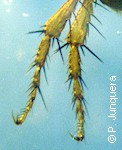
If you are not familiar with the general biology of insects click here
Adult fleas are obligate bloodsucking insects (hematophagous), i.e. they cannot survive or reproduce without blood. They have no wings, are 1 to 2 mm long and have a dark reddish-brown color. Their body is laterally flattened for easier moving in the host's hair coat.
As in all insects, the body of fleas is divided in three parts: head, thorax and abdomen. The head carries the eyes, the antenna, the piercing mouthparts, and often a kind of comb called ctenidium made of an array of spicules. Some species have more than on such comb. The 3 pairs of legs inserted in the thorax end each with a claw for better holding on to the hosts' hairs or feathers. The abdomen has usually 10 segments and includes the genital organs.
Adult fleas are extraordinary jumpers. They can jump vertically up to about 20 cm and horizontally up to about 35 cm, which is more 100 to 200 times their size. For a human this would mean jumping over a 70 story building or over 3 soccer fields!
As in all insects, the body of fleas is covered by a hard external structure called the exoskeleton, which protects the internal organs from mechanical pressure and pathogens. It also serves as anchor for the muscles. The exoskeleton includes a cuticle, which contains chitin, a substance specific for insects, other arthropods (e.g. spiders, ticks, crustaceans, etc.) and fungi. Chitin is a complex polymer of N-acetylglucosamine, a sugar derivative, which is synthesized in the skin cells and is responsible for the toughness of the exoskeleton, while being quite flexible. The cuticle of fleas is particularly tough and covered with many hairs and spines that help the fleas to move inside the host's hair coat.
Life cycle and behavior of dog and cat fleas
Fleas undergo a complete metamorphosis (i.e. they are holometabolic) that includes 4 developmental stages: egg, larva (stages I, II and II), pupa (or cocoon), and adult (also called imago).
Flea eggs
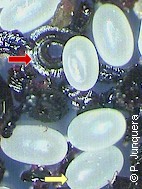
After hatching, adult females start laying eggs 24 to 26 hours after their first blood meal. A single female lays an daily average of 25 eggs during 50 days, but she can continue laying eggs for longer than 100 days. This means that a single flea can lay up to 2000 eggs in her lifetime. However, host grooming usually kills many adult fleas before they have started oviposition, which reduces such a high reproductive potential.
Cat flea eggs are about 0.5 mm long, and of a whitish color. Females lay the eggs in the host's hair coat, but they easily fall to the ground. Obviously, eggs will be more numerous wherever the pets use to sleep or rest for longer periods of time.
Eggs hatch 1 to 10 days after oviposition, depending on temperature and humidity. The warmer and hotter, the faster the hatching. Most eggs do not survive below 50% humidity.
Flea larvae
Newly hatched (stage I) larvae move freely in their environment. They are 1 to 2 mm long, of a white color, and have 13 segments. They grow and molt twice until reaching maturity. After each molt they leave the old skin (called exuvia). Molting is regulated by two hormones: ecdysone and juvenile hormone. A high level of juvenile hormone inhibits metamorphosis, whereas a high level of ecdysone favors molting. Mature larvae are 4 to 5 mm long.
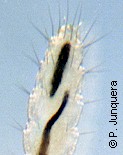
The larval stage lasts 4 to 11 days, strongly depending on temperature, humidity and availability of food. Flea larvae feed on feces of the adult fleas, which consist mainly in incompletely digested blood. They also feed on other flea eggs, old skins (exuvia) and also other larvae, i.e., they are cannibalistic.
Flea larvae tend to crawl downwards (positive geotaxis) and prefer darker places. They crawl deeply into carpets and rugs, inside mattresses and upholstery, in cracks and crevices in the soil filled with organic material, below plant debris in gardens and lawns, etc. There they find the appropriate microclimate: moderate temperature and high humidity. Flea larvae can survive outdoors (gardens, lawns, backyards, barns, stables, etc.) but the most adequate environment is usually indoors.
Most larvae do not crawl more than 10 to 20 cm beyond the place where the eggs hatched. This means that they they are particularly numerous in those places the pets prefer for sleeping and resting.
Flea pupae (cocoon)
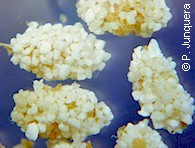
Mature larvae stop feeding and crawling, spin a protective silk cocoon and develop to pupae inside the cocoon. Cocoons have an oval form and are of a whiitsh color. They are 0.5 mm long and have sticky silk fibers. The dirt and soil particles of the immediate environment stick to those fibers perfectly camouflaging the cocoon in its environment and thus protecting it from potential predators (e.g. ants).
Pupae do neither feed nor move. This means that they concentrate in the same places as eggs and larvae, i.e. in carpets, rugs, mattresses, upholstery, below furniture, pet's nests and cradles, etc.
Flea pupae are very resistant to dryness, but they do not survive long periods below 5°C or above 35° C. Most insecticides are not capable of penetrating inside the cocoon.
Development to adult fleas inside the cocoon is completed in 5 to 10 days. However, newly formed adults do not hatch immediately but remain inside for up to six months as preemerged adults, waiting to hatch at the right moment.
Adult fleas (imagos)
Preemerged adults remain inside the cocoon and do not hatch until they perceive signals that a suitable host is around: body heat, step pressure, carbon dioxide (exhaled by the host), etc. Vacuuming also simulates flea hatching. This behavior reduces the risk for hatching and starving in absence of suitable hosts. In addition, as long as preemerged flea remains inside the cocoon it remains protected from predators. Preemerged adults are also more resistant to extreme temperatures and dryness than hatched adults.
Within a flea population, e.g. in an apartment, in a barn, etc., adults usually do not hatch suddenly altogether, but temporarily staggered, i.e. they hatch in groups, first one group, later another one, and so on, partly ignoring the previously mentioned signals of the presence of suitable hosts. It is thought that there could be a kind of communication between pupae. This staggered hatching is called the pupal window effect.
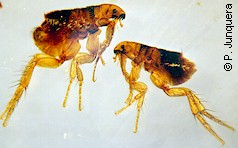
All these factors increase the survival chances of flea populations and makes it more difficult to control them.
Newly emerged unfed fleas are especially aggressive and are attracted by several stimulants produced by potential hosts, especially body heat, exhaled carbon dioxide and movements. They are also attracted by light (in contrast with the larvae), especially intermittent light. And they are negatively geotactic, i.e. they move upwards, not downwards as larvae. This is why newly emerged adult fleas move to the surface of carpets, rugs, vegetation, etc., where suitable hosts are likely to be.
When a host comes near enough, hungry fleas just jump on it and move around in the hair coat searching for a suitable place to bite and suck blood. Once a flea has found a suitable host, usually it does not leave it unless it is forced to. This means that the fleas the re-infect a pet come mostly from the pet's environment and not from contact with another pet infested with fleas, although this can happen as well.
Flea populations
If an owner discovers fleas on his pet, it is very likely that a flea population has become established in the pet's environment, i.e. in the household. The structure of average flea populations looks like a pyramid with four floors. The first floor are the eggs, which represent about 50% of the population. Larvae make about 35% of the population and are the second floor. Pupae are about 10% of the population in the third floor. And adults in the top floor are only 5% of the population. This means that 95% of the fleas are not on the pets, but in the environment, waiting for a host to pass by or to complete development.
Therefore keep in mind that solving a flea problem means not only controlling adult fleas on the pet, but requires controlling the whole flea population in the household, not only the fleas on the pets.
These numbers reflect the fact that many eggs and larvae do not survive because they are predated by natural enemies (e.g. ants) or fellow larvae that are cannibalistic, because they do not find a suitable environment, because thy do not find food, etc.
In countries with moderate climate and cold winters, fleas overwinter as adults in domestic or wild animals, but also indoors as preemerged adults in adequate microclimates.
Harm to dogs and cats caused by fleas
It is estimated that flea-related diseases represent more than 50% of the dermatological cases reported by veterinarians, and close to 35% of their effort.
During their blood meals fleas inject saliva into the wound to prevent the blood from clogging. Flea saliva contains irritant substances that cause the typical itching. As it happens to human beings, whereas some pets are quite tolerant to flea bites and are not or only slightly annoyed, other pets can be very sensitive.
Some pets can become hypersensitive to flea saliva and react intensively to flea bites with typical allergic reactions such as appearance of skin redness (erythema), bumps (papules), scabs (crusts), hair loss, etc. Dogs are especially affected on the neck, ears, lower back, thighs and the tailhead. This condition is called Flea Allergy Dermatitis (FAD). Severe FAD cases can lead to self-mutilation due to exacerbated scratching and grooming. DAP can develop without proportion to the number of fleas. In extreme cases a single flea can already cause FAD in a hypersensitive pet. FAD can be alleviated with anti-allergic medicines, but a long-term solution requires adequately protecting the pet against fleas.
Severe flea infestations can also cause iron deficiency anemia due to blood loss.
Diseases transmitted to pets by fleas
Fleas are also transmitters (vectors) of various human and pet diseases and parasites.
The oriental rat flea, Xenopsylla cheopis, is the primary vector of typhus caused by Rickettsia typhii, but it has been demonstrated that the cat flea, Ctenocephalides felis, can also act as vector of this disease.
The bacterium responsible for bubonic pest, Yersinia pestis, is also transmitted by Xenopsylla cheopis, the oriental rat flea, but other species can occasionally transmit this disease as well, including the cat flea, Ctenocephalides felis. However, bubonic pest is nowadays a rather infrequent disease.
The cat flea (Ctenocephalides felis), the dog flea (Ctenocephalides canis), and the human flea (Pulex irritans) can all three transmit Dipylidium caninum, the double-pored dog tapeworm that infests dogs and cats, and occasionally children. Flea larvae eat the eggs of the tapeworm, which develop to infective stages (cysticercus) inside the larvae. Dogs and cats ingest infected fleas while grooming and become themselves infected.
Flea control and prevention: strategic considerations
The most important thing to know about flea control is that a flea problem is almost always a flea population problem!!!
Nowadays a full arsenal of highly effective flea control products is available to pet owners. There are even too many, often with significant differences regarding efficacy, length of protection, spectrum of activity (i.e. whether they control other parasites such as ticks, mites, lice, worms, etc. or not), price, safety, etc. As a consequence it can be difficult for pet owners to find out which ones fit better to their needs. And such products have to be used correctly.
Knowing that 95% of the flea population is not on the pets but in the environment, and that population control is a key to successful flea control, it must be said that using a particular product may not be enough to solve the problem: a combination of chemical with non-chemical control tools may be required.
Which control tools are indicated depend a lot on important objective factors that influence the flea problem, e.g.:
- Seasonality: seasonal occurrence (e.g. in moderate climates with cold winters) vs. year-round occurrence (e.g. in most tropical and subtropical regions)
- Location: e.g. urban vs. rural environment.
- Household type: e.g. single pet vs. multi pet households
- Re-infestation risk: e.g. frequent vs. infrequent contact with other potentially infested pets or wildlife
- Annoyance level for pets and humans. e.g. pets affected by Flea Allergy Dermatitis (FAD) or not.
Personal preferences, i.e. subjective factors that are independent from the flea problem itself but also important when choosing a control tool, e.g.:
- Wish to keep humans (e.g. children) unexposed to chemicals
- Out-of pocket cost of flea control
- Willingness to invest time in understanding and managing the flea problem.
- etc.
In a place with a cold winter (e.g. in the Northern United States, Canada, most of Europe, etc.) the flea problem "disappears" during the winter months. Correctly speaking, only the adult fleas disappear, all other stages remain in place waiting for the next warm season, but immature stages do not bite. This means that the problem does not disappear, it just takes a break. In this cases, it is highly advisable to start preventive treatments before the real problem starts again in the next season, i.e. before any signs of fleas have been noticed. Remember: "no adult fleas" does not mean "no fleas"!
If a pet catches occasionally 2 or 3 fleas, the owner will probably not notice it. These few fleas won't leave the pet to jump onto the owner and bite him. Consequently the perception is that "there is no flea problem". However, if the eggs produced by these fleas find a suitable environment, a problem can quickly develop.
If a pet owner perceives a "flea problem", this means most frequently that he/she or someone else in the household has been already bitten. And this means almost always that either the pets carry too many fleas and a few ones look for a new prey; or that many fleas are hatching out of cocoons in the environment and will jump onto anything that is warm and moves around. Or both things together: pets carry many fleas, and more are breeding in the environment: there is already a "flea population problem".
To face a flea problem, a key question is to estimate the size of the flea population. A sporadic flea infestation of a pet in a cold place, if quickly discovered can be often solved with a few treatments of the affected pet, because those fleas won't have time to lay too many eggs and infest the whole environment. But controlling a well established flea population in a household in a warm and humid region requires mostly continuous and consequent flea control and preventative measures.
As a thumb rule, if your or another person in the household is regularly bitten by fleas, there is definitely a flea population problem in the household that requires immediate action. If no person is bitten, but the pet is seen to scratch here and then, there may not be a population problem yet, but it is likely to develop if you do nothing.
- Click here to view the article on NATURAL CONTROL of fleas in dogs and cats (traps, natural insecticides, medicinal herbs, vaccines, biological control, etc.)
- Click here to view the article on CHEMICAL CONTROL of fleas in dogs and cats (spor-ons,collars, pills & chewables, injectables, shampoos, soaps, sprays, baths, powders, etc.)